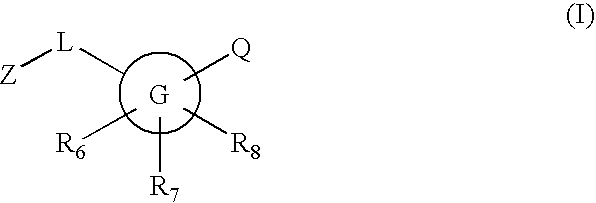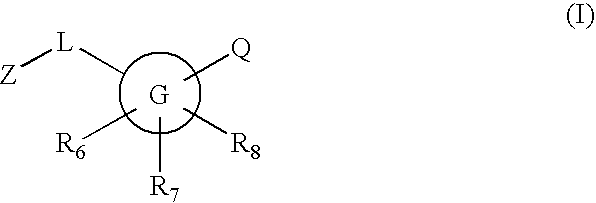Inhibitors of 11-beta hydroxysteroid dehydrogenase type I
- Summary
- Abstract
- Description
- Claims
- Application Information
AI Technical Summary
Benefits of technology
Problems solved by technology
Method used
Image
Examples
example 1
[0368] Compound 1C (200 mg, 0.853 mmol) in DCM (10 mL) was treated with 1N PBr3 (0.64 mL, 0.64 mmol) at 0° C. for 1.5 hours. The mixture was quenched with 5 mL saturated NaHCO3 solution at 0° C. The solution was diluted with DCM. The organic layer was separated, washed with brine, and dried over MgSO4. The drying agent was filtered, and the filtrate was concentrated via vacuum to yield the bromide as a colorless oil. The bromide was dissolved in THF (10 mL) and treated with 2,6-dichlorothiophenol (153 mg, 0.853 mmol) and N,N-diisopropyl-ethylamine (331 mg, 2.56 mmol) at room temperature overnight. The mixture was concentrated and purified by column chromatography to yield Example 1 (76.7 mg) as a white powder. HPLC Rt (Method A: 3.618 min. LCMS: m / z 395 (M+H+). HPLC purity: 99%. 1H NMR: δ 8.42 (s, 1H), 8.31 (s, 1H), 7.58 (s, 1H), 7.30 (d, J=8.2 Hz, 2H), 7.15 (t, J=8.2 Hz, 1H), 4.70-4.55 (m, 1H), 4.08 (s, 2H), 3.60-3.48 (m, 1H), 3.08-2.86 (m, 1H), 2.85-2.70 (m, 1H), 1.80-1.57 (m, 3H)...
example 2
(5-((2,6-Dichlorophenylsulfonyl)methyl)pyridin-3-yl)(4-methylpiperidin-1-yl)methanone
[0369]
[0370] To a solution of Example 1 (58 mg, 0.147 mmol) in THF (2 mL) and MeOH (2 mL) was added 1-(p-toluenesulfonyl)imidazole (261 mg, 1.18 mmol), 30% aqueous H2O2 (240 μL, 2.352 mmol), and 1 N NaOH (2.7 mL, 2.7 mmol). The mixture was stirred at room temperature for 2.5 hours. The organic solvents were removed in vacuo, and the aqueous portion was diluted with brine and ethyl acetate. The organic portion was separated, and the aqueous layer was extracted again with ethyl acetate. The organic extracts were combined, dried over MgSO4, and concentrated. The residue was subjected to preparative HPLC to yield Example 2 (41 mg) as a white powder. HPLC / Rt): 2.868 min. LCMS: m / z 427 (M+H+). HPLC purity: 99%. 1H NMR δ 8.57 (s, 1H), 8.33 (s, 1H), 7.82 (s, 1H), 7.40-7.32 (m, 3H), 4.64 (s, 2H), 4.57-4.54 (m, 1H), 3.62-3.48 (m, 1H), 3.05-2.97 (m, 1H), 2.82-270 (m, 1H), 1.80-1.70 (m, 1H), 1.70-1.52 (m, 2H),...
example 3
[0375] To a solution of compound 3C (80 mg, 0.296 mmol) in THF (2 mL) at RT was added 2,6-dichlorobenzenethiol (212 mg, 1.184 mmol), and PPh3 (233 mg, 0.888 mmol). After the solution became homogeneous, diisopropyl azodicarboxylate (180 mg, 0.888 mmol) was added via syringe. After 5 minutes of stirring at RT, the mixture became cloudy. DCM (1.5 mL) was added and stirring was continued for another 2 hours. The precipitate was filtered off, and the solvents were removed at reduced pressure. The residue was purified by silical gel chromatography, followed by prep HPLC to give Example 3. HPLC Rt (Method A): 3.788 min. LCMS: m / z 431 (M+H+). HPLC purity: 97%. 1H NMR: δ 8.80 (s, 1H), 7.93-7.88 (m, 1H), 7.36-7.20 (m, 4H), 4.28 (s, 2H), 3.80-3.73 (m, 2H), 2.36-2.22 (m, 2H), 1.81-1.63 (m, 2H), 1.45-1.26 (m, 3H), 0.97 (d, J=5.1 Hz, 3H).
PUM
| Property | Measurement | Unit |
|---|---|---|
| Volume | aaaaa | aaaaa |
| Mass | aaaaa | aaaaa |
| Mass | aaaaa | aaaaa |
Abstract
Description
Claims
Application Information
 Login to View More
Login to View More - R&D
- Intellectual Property
- Life Sciences
- Materials
- Tech Scout
- Unparalleled Data Quality
- Higher Quality Content
- 60% Fewer Hallucinations
Browse by: Latest US Patents, China's latest patents, Technical Efficacy Thesaurus, Application Domain, Technology Topic, Popular Technical Reports.
© 2025 PatSnap. All rights reserved.Legal|Privacy policy|Modern Slavery Act Transparency Statement|Sitemap|About US| Contact US: help@patsnap.com



